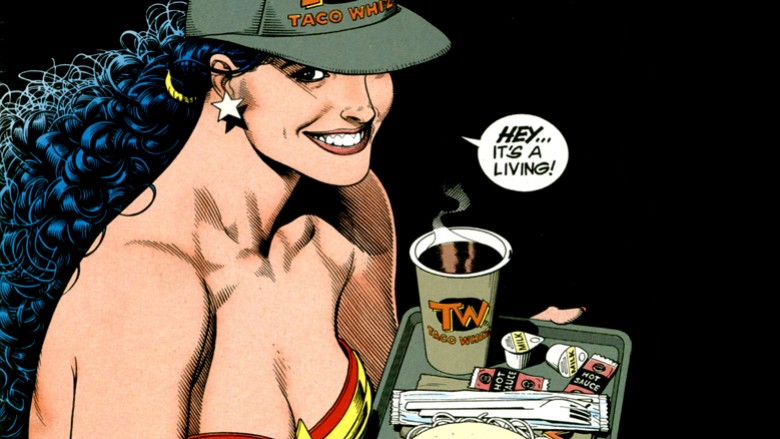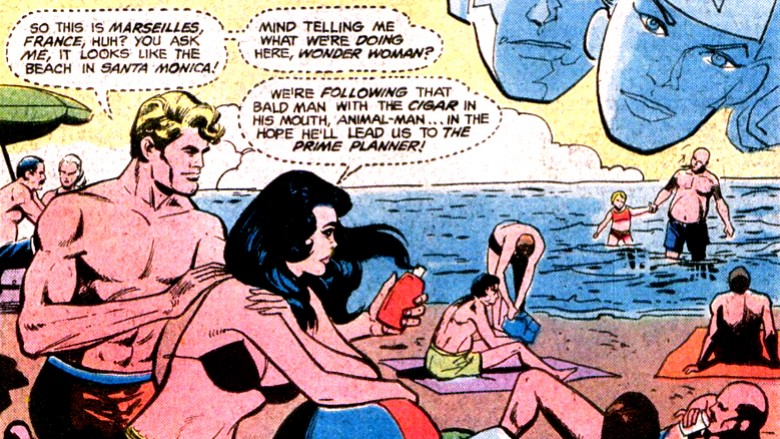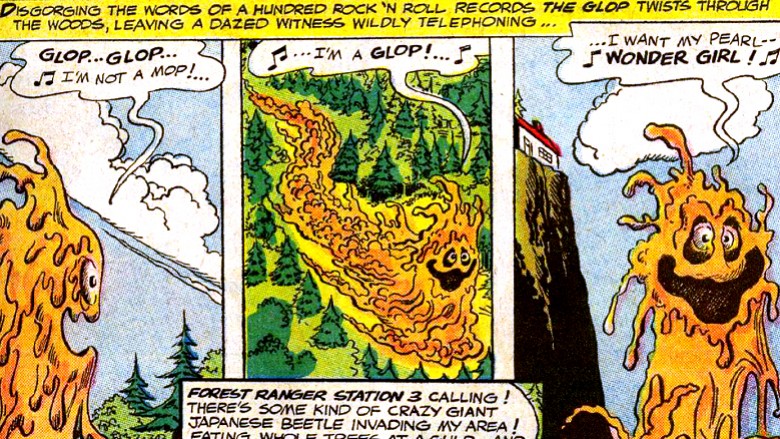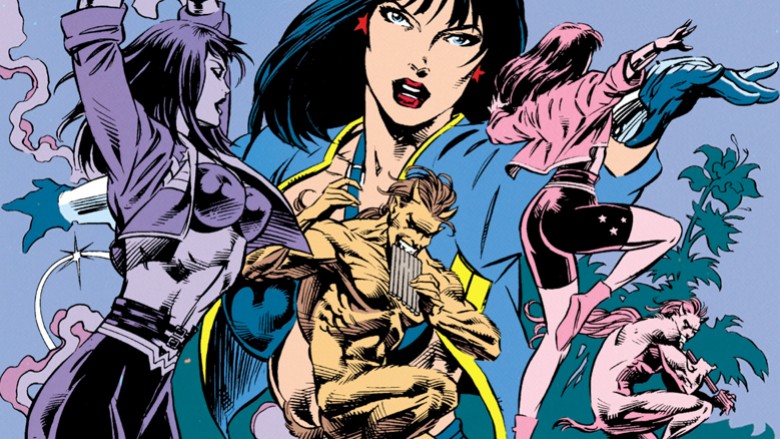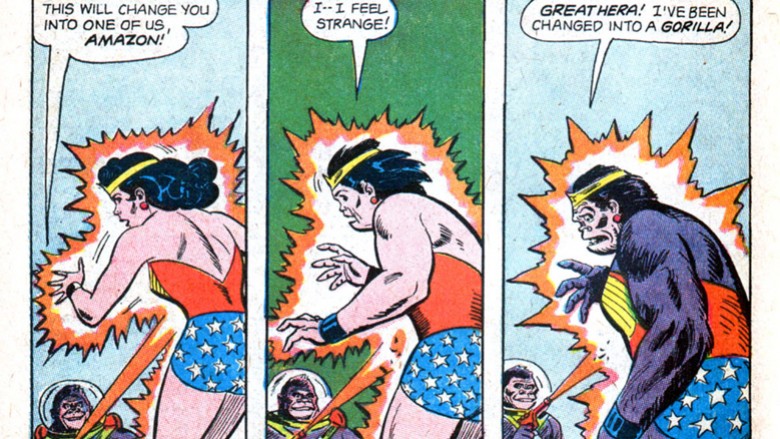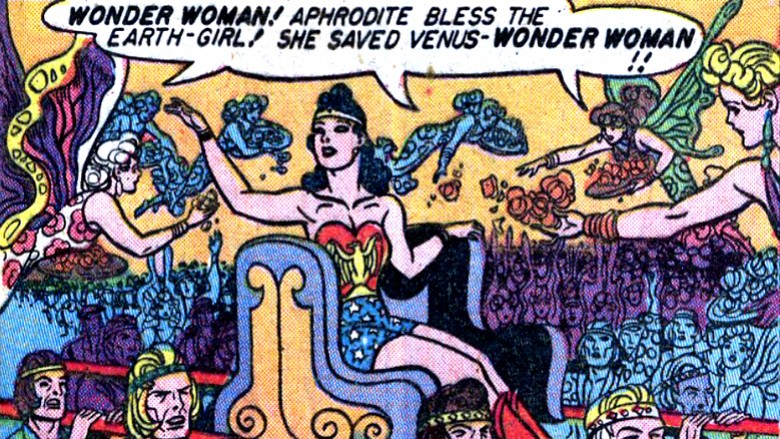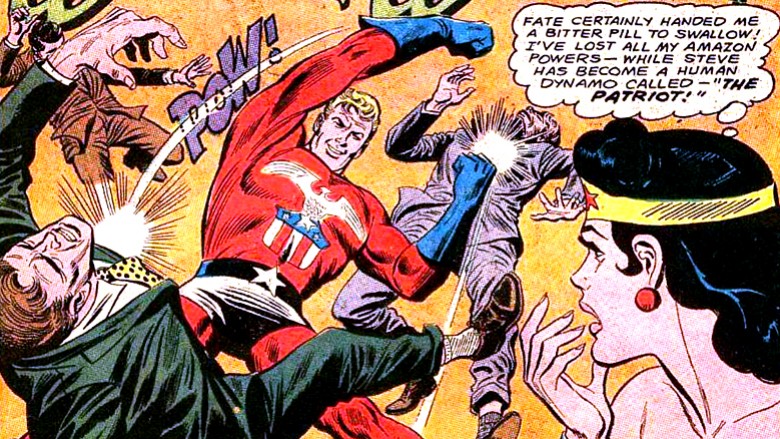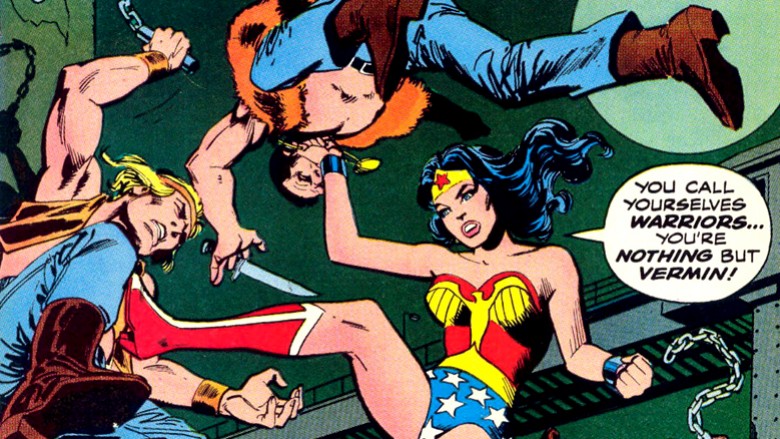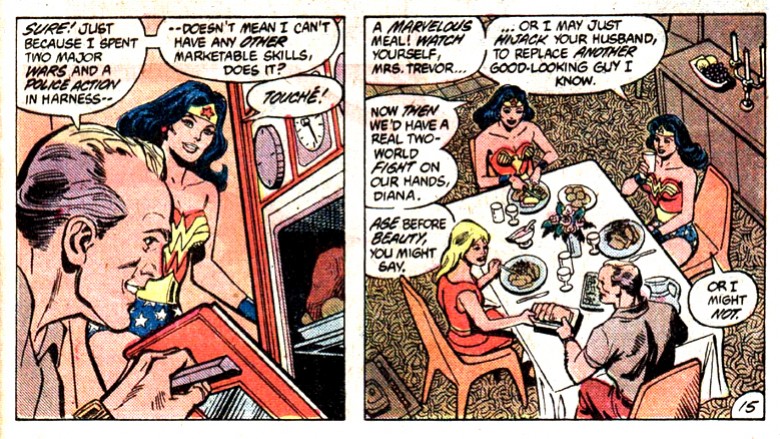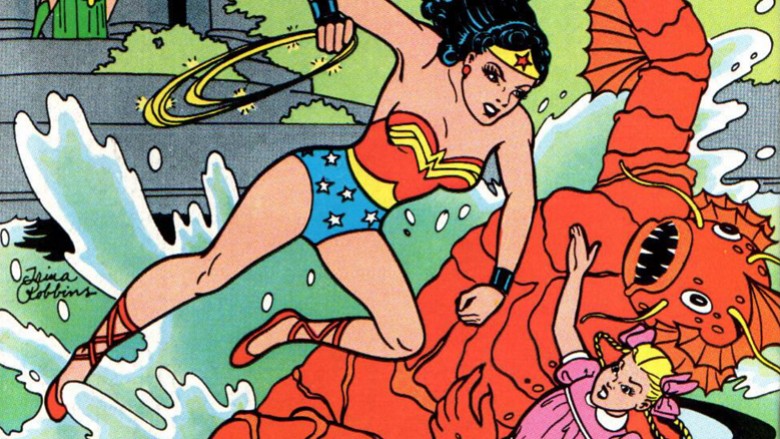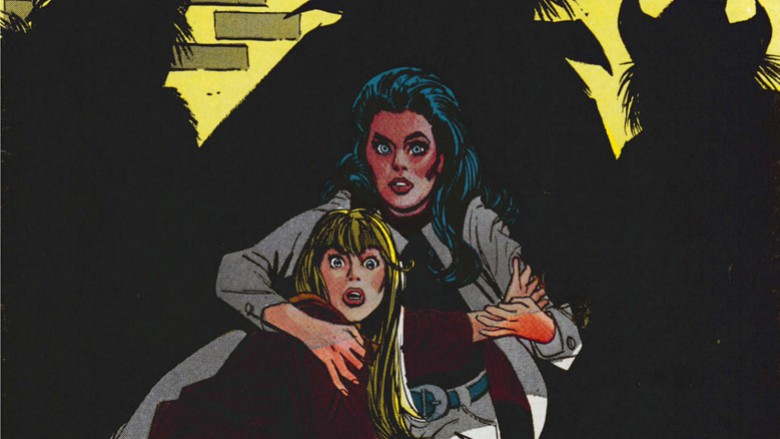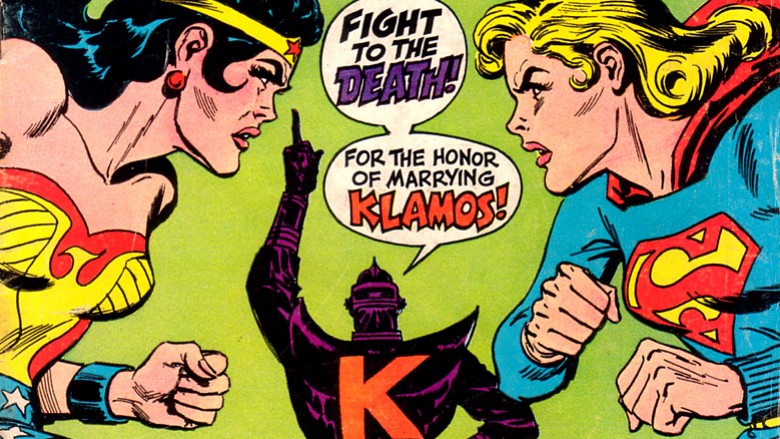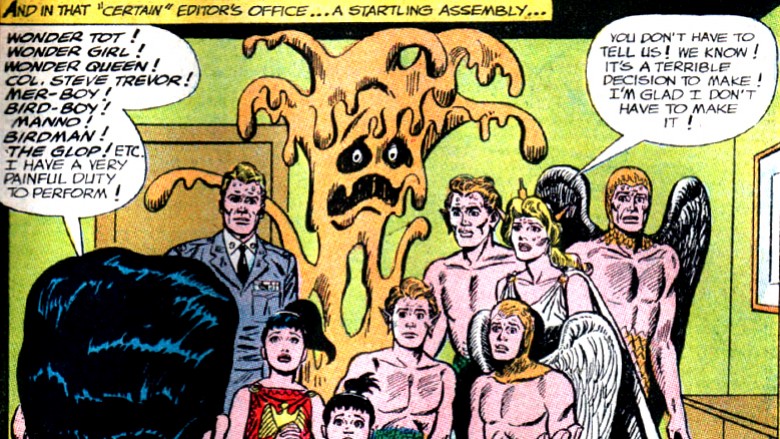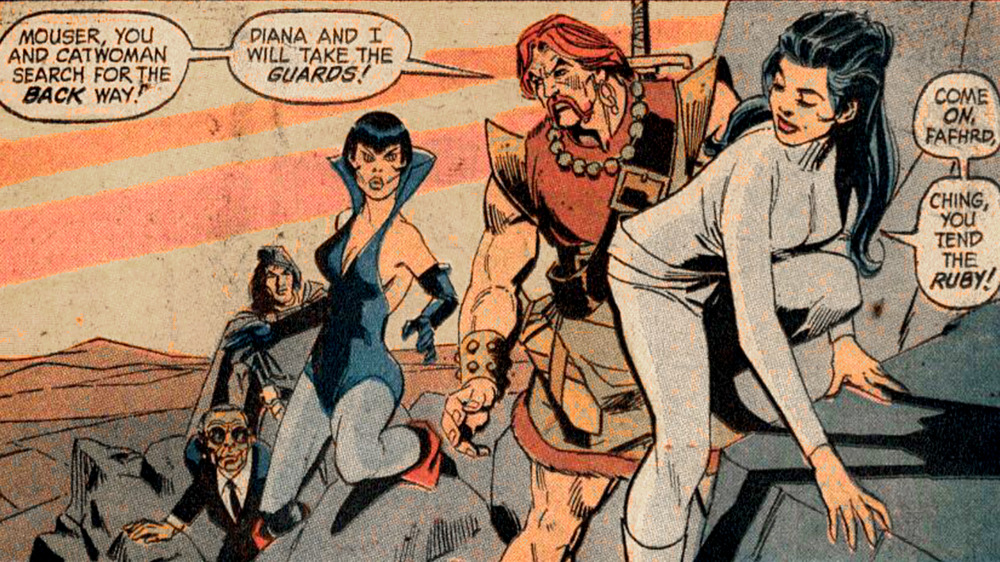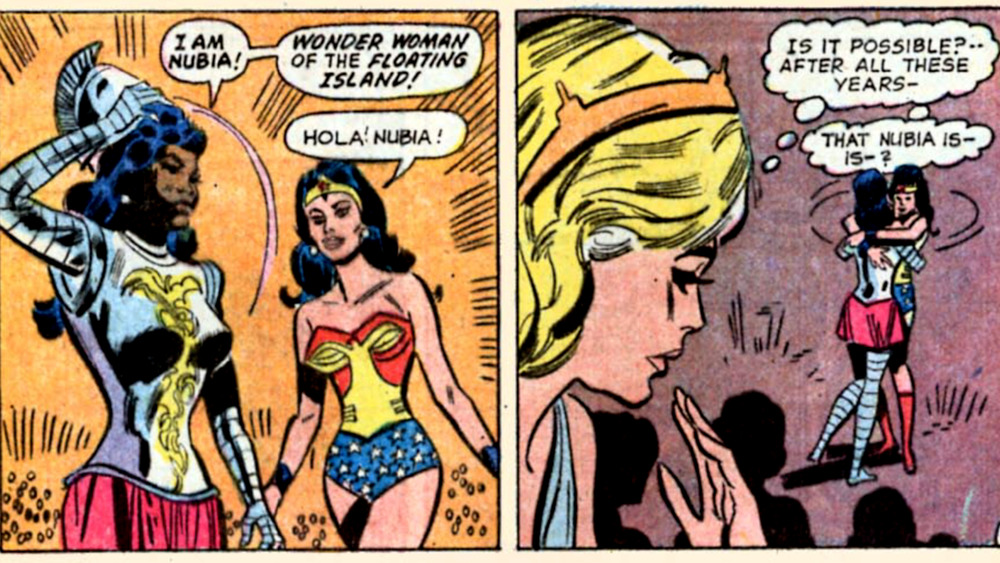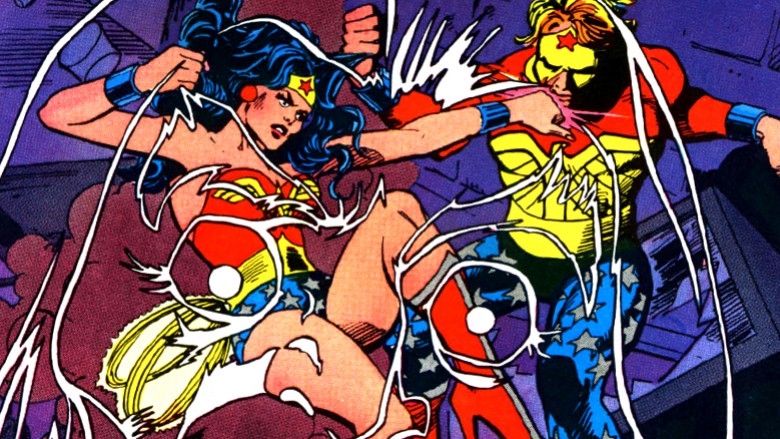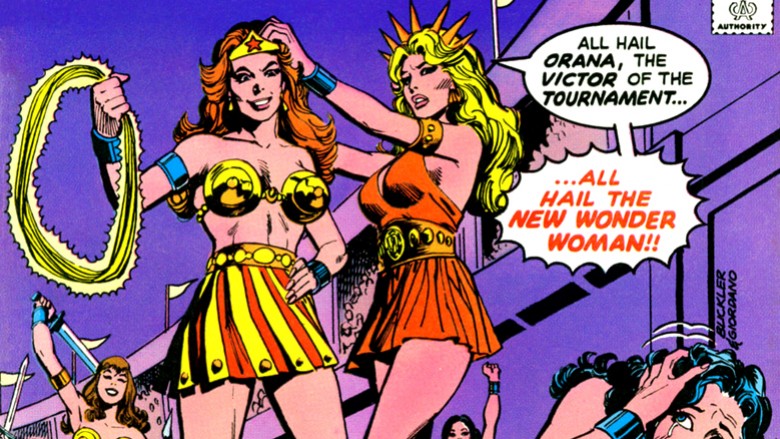What Diehard DC Fans Don't Even Know About Wonder Woman's Past
When the same character appears in new stories nonstop for more than 75 years, their history is bound to get a little complicated. This might be even more true with Wonder Woman, because her past includes a lot of creators throwing things at the wall to see what sticks.
Just about everyone knows Wonder Woman's early years were full of bondage imagery. Most comics fans are also aware that she gave up her costume in the late '60s to become a mod adventurer in the Emma Peel mode. And surely everyone knows her recent history of dating Superman and making other questionable choices.
So what else has she done since 1941? What are the parts of Wonder Woman's history you won't learn from any 75th Anniversary Collection? Here are some forgotten moments from the long life of Princess Diana, the Amazing Amazon.
She's worked in fast food
Wonder Woman's best known, depending on your favorite era, as an army secretary or a professional diplomat, but in Wonder Woman Vol. 2 #73, by William Messner-Loebs and Lee Moder, she serves tacos for minimum wage. It all starts when Diana returns from outer space to find the island of Themiscyra and all its Amazons mysteriously missing. Left with no money and her job as an ambassador null and void, the Princess has no choice but to find a job on her own. With no formal college degree and not much of a resume (and too proud, we assume, to call up Bruce Wayne), she ends up at Taco Whiz, serving the DCU equivalent of Fourth Meal to long lines of rude customers.
Wonder Woman can do anything, of course, so she's a perfectly capable food service employee. But she's even better at doing other things, which is why by the end of the issue a private detective gives her a job punching criminals. And soon enough the Amazons would return and all would go back to normal.
She had a fling with Animal Man
Most people think of Steve Trevor as Wonder Woman's boyfriend, but at times in her history he's disappeared for years, and even died more than once. It was during one such Steveless era that Wonder Woman met Buddy Baker, the D-list hero known as Animal Man. In a Bronze Age two-parter by Gerry Conway and Jose Delbo, the pair definitely hit it off. Wonder Woman Vol. 1 #267 sees them meet in costume, and Animal Man has to remind Wonder Woman who he is. They team up to take on an international crime cartel, and Diana realizes Buddy isn't the goofball she first took him for. On the splash page of issue #268, the heroes are decidedly out of costume on a beach in France, with Buddy rubbing sunscreen on the bikini-clad Amazon's back. It wouldn't be long before Animal Man would get married and have kids, while Wonder Woman was rebooted by Crisis on Infinite Earths. But in Marseilles in 1980, they clearly shared something special.
She was stalked by a singing blob
DC's Silver Age comics are famously weird, but Wonder Woman's might be the weirdest. Writer Bob Kanigher and artist Ross Andru basically did whatever popped into their heads. To start with, the adult Wonder Woman shared her book with her teenage self, Wonder Girl, and her toddler self, Wonder Tot, and in fact the trio often appeared in stories together with only the vaguest explanations of how that was possible.
The Glop, who showed up in Wonder Woman Vol. 1 #151, was really only interested in Wonder Girl. He was described as a teenager himself, although it was hard to tell, because he was just a giant pile of slime from outer space. But when he absorbed a bunch of rock 'n' roll records, he started singing his own kooky songs, mostly about how much he wanted to date Wonder Girl. It was a pretty unsettling proposition, but fortunately the whole thing turned out to be a dream. Of course, this being comics, that didn't stop the Glop from making further appearances over the years.
The god Pan taught her to dance
At the height of the '90s, William Messner-Loebs and Mike Deodato put Princess Diana through the ringer. This was when the Amazon known as Artemis became the official Wonder Woman, leaving Diana to run around in a jacket and bike shorts.
When Diana faces the Joker in Wonder Woman Vol. 2 #97, she has a hard time dealing with his brand of violent chaos. So she turns to the most chaotic being she knows, the literal Greek God Pan. Explaining that she must better understand chaos to fight it, she asks the goat-legged god, "Teach me your dance." Pan does just that, and when Diana returns to the mortal plane, she takes down the Joker and tells jokes of her own along the way.
She turned into a gorilla
Wonder Woman Vol. 1 #170 features another Silver Age adventure by Kanigher and Andru, and that means another unsettling suitor from outer space. This time it's an intelligent alien gorilla who wants to make Wonder Woman his queen, and uses a raygun to change her into a gorilla as well. She talks her way back into humanity by explaining that as a human she's an Amazon of mythical beauty and grace, but as a gorilla she's just like any other female gorilla. Then she tricks the space gorilla into using the gorilla ray on himself, making him a human man. That enables her to use her magic lasso, which doesn't work on animals, to compel him to leave Earth in his flying saucer. The sight of Wonder Gorilla is certainly striking, but really it's just another day in the DC Silver Age.
She was the greatest hero of the planet Venus
In All-Star Comics #13, Nazi agents capture the Justice Society of America, put each of them inside a small rocket, and launch them into space. Each hero ends up on a different planet in our solar system, and naturally all of those planets are home to intelligent life. Starman assists the sentient robots of Jupiter, Johnny Thunder helps out the giant spiders of Mercury, and so on.
Wonder Woman's chapter is by her creators, William Moulton Marston and Harry Peter, so naturally the Amazing Amazon finds herself on Venus, the matriarchal planet. There are men on Venus, but they're soft and sensitive and generally subservient to the winged women who rule their world.
However, just as Wonder Woman arrives, Venus has been invaded by hulking patriarchal "Meteor Men." None of the Venusians are prepared to fight them, but Wonder Woman takes them down easily and is hailed as the savior of Venus. Queen Desira of Venus promises to return the favor whenever she can, and goes on to become a recurring character in Wonder Woman's own book.
She was pushed aside when Steve Trevor became an ersatz Captain America
Steve Trevor's an okay guy, but he was never a superhero himself. Except for when he totally was! In Wonder Woman Vol. 1 #174, a Bob Kanigher/Irv Novick joint from late in the Silver Age, Steve becomes the Patriot, a superhero of exceptional strength and speed whose All-American costume immediately brings to mind a certain other blond gentleman named Steve.
It's a good thing the Patriot is here to save the day, because by some strange coincidence Wonder Woman has mysteriously lost her powers at the same time. Except it's not a coincidence at all, of course. It's all a plot by the Angle Man, Wonder Woman's greatest Silver Age nemesis. His latest angle is to get Wonder Woman to retire by simultaneously stealing her powers and making her feel like Steve has replaced her. Wonder Woman doesn't give up so easily, and soon enough everything is back to the status quo. Even if he may superficially resemble Steve Rogers, Steve Trevor is much more comfortable in his army uniform than spandex and buccaneer boots.
She fought the Warriors
Walter Hill's The Warriors is a cult classic now, but in 1979 it was a fresh piece of pop culture. And anyone who'd seen it would recognize the shirtless, vest-clad trio on the cover of Wonder Woman Vol. 1 #262. In case you didn't, Wonder Woman is even shown saying, "You call yourselves Warriors...."
It's obvious that Gerry Conway and Jose Delbo had seen the movie and couldn't resist referencing it in their comic. The Warriors only appear for a few pages of the actual story, in which Wonder Woman teaches them a rough lesson about how crime doesn't pay. It's hard to say if Conway was a fan of the movie or had a problem with its glamorization of street gangs and was trying to make a point. Either way, it's fun to see a Bronze Age comic deal so directly with what was going on in other media at the time.
She married Steve Trevor and had a daughter
One of the great things about the old DC Multiverse is that it gave the original heroes a chance to retire and live out their lives on Earth 2, while their younger counterparts were still having new adventures over on Earth 1. For Wonder Woman Vol. 1 #300, Roy and Danette Thomas teamed up with veteran Wonder Woman artists Ross Andru and Dick Giordano for a story about Earth 1's Wonder Woman visiting her older self on Earth 2.
Being immortal, the Earth 2 Wonder Woman doesn't look any older, but she's married to a noticeably 60-something Steve Trevor, and they even have a teenage daughter who has her father's blonde hair but her mother's powers. Young Hippolyta (named after her grandmother, of course) would go on to become a superhero in her own right, and eventually be a supporting character in Neil Gaiman's Sandman.
She starred in a Trina Robbins comic
Trina Robbins is a legend, and rightfully so, but she's not known for mainstream superhero comics. A part of the Underground Comix movement of the late '60s, she injected feminism into a counterculture that was often just as hostile to it as the rest of society. Wonder Woman actually appears on the cover of Robbins' It Ain't Me Babe, a one-shot that preceded her long-running Wimmen's Comics anthology, but obviously nobody at DC signed off on that.
By the 1980s, on the other hand, Robbins had gained a lot of respect as a comics trailblazer, and DC was a lot more willing to give projects to idiosyncratic creators. So with some scripting assistance from Kurt Busiek, Robbins got to write and draw Princess Diana with DC's blessing for a 1986 miniseries called Legend of Wonder Woman. Marketed as the original character's last hurrah before the George Perez reboot, it mixed the Golden Age version of the character with Robbins' underground sensibility, with delightfully unique results.
She rescued a girl from a wicked lesbian street gang
Wonder Woman Vol. 1 #185, written and drawn by Mike Sekowsky, remains a particularly infamous story from the period when Wonder Woman had given up her costume and powers to become a stylish globetrotting adventurer, and also owned a fashion boutique in a New York City.
Returning to her shop one evening, Diana finds a teenage girl named Cathy, hiding in fear from a group she refers to only as "Them!" She turns out to be on the run from a trio of lesbian stereotypes, who want to keep her as a collared slave. Of course words like "gay" or "lesbian" are never used in the comic, but when a woman decked out in menswear is demanding that a girl put on a collar and be her slave, it's not hard to read between the lines, and it's pretty gross how this comic portrays queer people.
Wonder Woman makes short work of "Them," and fortunately the next time gay characters appear in Wonder Woman comics, it will be under far more positive circumstances.
She and Supergirl fought as gladiators to marry an alien warlord
From Superman to Thor and the Hulk, it seems every super-strong hero ends up in an alien gladiatorial arena sooner or later. It happened to Wonder Woman and Supergirl in Wonder Woman Vol. 1 #177.
An armored alien conqueror named Klamos has captured powerful women from all over the cosmos in his hunt for a bride, but none are as powerful as the Amazon and the Kryptonian he found on Earth. They don't want to fight each other, but Klamos is ready to destroy the Earth if they refuse.
The duo performs some pretty impressive wrestling moves, but it's all a setup for Supergirl to hurl Wonder Woman into the royal box where Klamos and his ever-present chamberlain Grok are watching. Diana hurls Grok back into the arena, where Kara reveals that he uses a wrist computer to control Klamos, who's nothing more than a robot. A whole galaxy is freed from tyranny, and the two heroes return home to Earth.
Her Silver Age supporting cast was fired on-panel
By 1965, Wonder Woman comics were getting sillier and sillier. Wonder Girl's love interests Mer-Boy and Bird Boy had begun appearing as adults—Mer-Man and Bird Man—to compete with Steve Trevor for Wonder Woman's affections. Wonder Woman was still teaming up with her younger selves, which led to Wonder Girl joining the Teen Titans because that team's creators understandably mistook her for Wonder Woman's sidekick (which is why she'd later be redefined as a separate character named Donna Troy). In short, everything was wacky and kind of a mess, at a time when other comics were just starting to grow up a bit.
So Robert Kanigher, who was editing as well as writing at the time, wrote himself into the book to fix the problem. Appearing as an unnamed editor in Wonder Woman Vol. 1 #158, Kanigher gathered the book's supporting cast in his office and "retired" them for the good of the comic. Wonder Woman, he promised, would abandon the excesses of the current era and return to the glory of the Golden Age. The Golden Age revival only lasted a few issues, but the housecleaning was important for the series' future.
She and Catwoman teamed up with a pair of old school pulp heroes
Fafhrd and the Grey Mouser were a pair of Sword and Sorcery heroes created by Fritz Leiber. They debuted in 1939 in the pages of Unknown, one of the sci-fi/fantasy pulp magazines that filled much the same role as comic books before comic books were a thing. The hulking barbarian Fafhrd and his roguish friend the Mouser appeared in many stories over the years, cementing them as genre legends alongside Robert E. Howard's Conan and Michael Moorcock's Elric. Then, in 1972, they met Wonder Woman and Catwoman.
Sci-fi legend Samuel R. Delaney wrote Wonder Woman Vol. 1 #202, which introduced the pair to the DC Universe. The story began in #201, written by Denny O'Neil, which ended with Diana, Catwoman, and Diana's martial arts teacher I-Ching being transported to the land of Nehwon and basically into the laps of Fafhrd and the Grey Mouser. Dick Giordano drew the whole story, in which the unlikely team have a pretty standard fantasy adventure involving magic gems. It ends with Fafhrd and the Mouser catching a glimpse of 1972 Earth, but they're happy to return to their simpler homeland.
This story was part of a pattern in the no-powers Diana Prince era of trying out different genres with the character, but this was perhaps the furthest out there. It was also something of a backdoor pilot for Leiber's heroes, who appeared in their own book, Sword of Sorcery, in 1973.
She had a Black sister named Nubia who was also a Wonder Woman
By 1973, Wonder Woman was back in costume and reunited with the Amazons. Meanwhile, comics started to take more interest in Black characters, although they were often the somewhat clumsy creations of white writers. So it can't have been surprising in Wonder Woman #204, by Robert Kanigher and Don Heck, when a heavily armored warrior woman removed her helmet to reveal herself as Black, declaring, "I am Nubia, Wonder Woman of the Floating Island." Nubia was a sort of opposite to Diana. Her breastplate was adorned with a lion instead of an eagle. Instead of a magic lasso, she had a magic sword. Instead of the princess of an island of all women, she ruled an island that was otherwise all men.
Queen Hippolyta seemed to recognize Nubia, and soon enough revealed the truth: Diana wasn't the only daughter she'd sculpted from clay. She had formed another child of darker clay, Nubia, who was stolen as an infant by the evil god of war, Mars. Mars raised Nubia to be his weapon against the peace-loving Amazons, but Diana freed her from his influence and the two became friends. Nubia in turn spread the message of peace to the men of her island, and everything was good.
Nubia was DC Comics' first Black heroine, and she's endured over the years. In fact she's getting her own graphic novel in 2021, from writer L.L. McKinney and artist Robyn Smith.
She fought a woman-hating male version of herself
Who is Captain Wonder? He first appeared in Wonder Woman Vol. 1 #289, and at first glance he looks like the Diana's male counterpart—the Supergirl to her Superman. He also looks like a buffed-up Steve Trevor, not unlike the Patriot from that earlier story. But Captain Wonder isn't a hero. He hates women, and wants to destroy them all, starting with Wonder Woman.
Beneath the mask and the handsome face of Captain Wonder is Wonder Woman's most misogynistic villain, Dr. Psycho, who used comic book science to take on the form of Steve Trevor's idealized fantasy of himself as Wonder Woman's equal. Once Steve wakes up from his dream, Psycho goes back to his usual diminutive self, enabling Wonder Woman to easily defeat a manifestation of sexism even more overt than her usual enemies.
She lost her title to a redhead... more than once
Everyone remembers how Princess Diana lost the Wonder Woman title in the '90s to an Amazon named Artemis. It was after Superman died and Batman got his back broken, so being replaced was the cool thing to do for DC heroes. But for Wonder Woman, it wasn't the first time a red-haired Amazon had stolen her job.
In Wonder Woman Vol. 1 #250-251, Jack Harris and Jose Delbo told a surprisingly similar story, where an upstart Amazon named Orana calls for a new tournament on Paradise Island, and manages to win the right to be Wonder Woman away from Diana. Although she's supposed to stay with the other Amazons, Diana sneaks back to New York in her Diana Prince identity and keeps an eye on Orana, who has a hard time getting anyone to accept that she's a valid Wonder Woman. She's also not particularly good at the job, and ultimately sacrifices her life in battle against a villain named Warhead. Diana returns Orana's body to Paradise Island, and solemnly resumes the mantle of Wonder Woman.
Almost two decades later, the Artemis storyline was pretty much the same, but longer and with more twists and turns along the way. That's the thing about long-running superhero comics. Even the strangest things often happen more than once, because the story cycle just keeps on turning.

